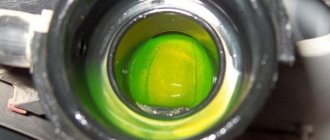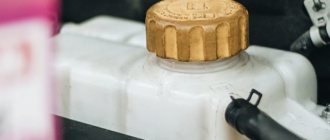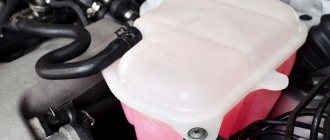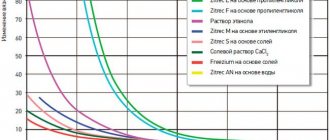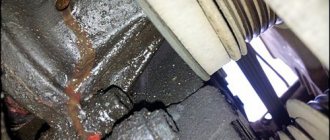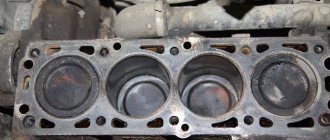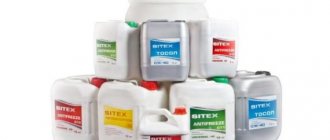As you know, coolant is an important consumable element in the system of any car. Therefore, the choice of refrigerant is a priority when replacing it. Today we will tell you how to determine whether “Tosol” or antifreeze is filled, and what are the differences between these substances.
Many experienced car enthusiasts know that optimal and efficient operation of a vehicle’s engine is ensured by high-quality coolant filled in. If the consumable material is really good, then it can extend the service life of engine components, as well as ensure their normal operation.
Antifreeze and antifreeze from various manufacturers, distilled water
What to do if you don’t know what kind of coolant (hereinafter referred to as coolant) is in your car? Determining this is not as easy as it seems at first glance.
Why does a motorist need to know this?
As a rule, motorists know what is in their cooling systems. But this is the case if we are talking about the permanent owner of the car. In fact, there can be a lot of reasons why a motorist wants to find out what exactly is poured into the expansion tank of his car. Eg:
- The vehicle was recently purchased - it would be logical to find out what refrigerant is in the system and when it was last changed.
- There are problems with the car's cooling system - the heater is not working well, the engine periodically boils. In some cases, these consequences may be caused by poor-quality consumable fluid. Then the motorist will be interested in knowing what consumables are in his car so that he never uses it in the future.
- The cooling system works great over time and overall there are no shortcomings. In this case, the driver will also be interested to know what is poured into the system - “Tosol” or antifreeze, so that in the future he can fill in this particular coolant.
Pink coolant in the expansion tank
So is there a difference?
And yet, car owners continue to stubbornly talk about the differences between antifreeze and antifreeze. They really exist, if we talk about the chemical composition. Well, and as a result, there will be differences in properties. The most common antifreeze is based on ethylene glycol (40%), distilled water and 10 special additives that protect the liquid from foaming (phosphates, silicates, nitrites, nitrates). This coolant coats the inside of the engine with a special anti-corrosion layer. Its thickness is about half a millimeter.
In addition to ethylene glycol, propylene glycol is added to imported antifreezes. Well, and, of course, additives. Only here there are already about 40 of them. Moreover, the composition of the additives differs for different antifreezes, which causes differences in characteristics. For example, in freezing temperatures.
To make it easier to distinguish them visually, manufacturers add dyes: red, blue, green, yellow. Liquids of the same color, even if they are from different manufacturers, can be mixed with each other without any consequences. But you should pay attention to where the refrigerant is produced. The fact is that Japan and Europe have different standards. Europeans also use colored markers to determine the tolerance class according to the VW classifier. Therefore, there is no point in mixing Japanese products with European ones. Likewise, mixing different colored refrigerants, even from the same manufacturer, can lead to sedimentation and foam formation. Of course, inquisitive car enthusiasts have a question about whether it is possible to add antifreeze to antifreeze. This cannot be done, since in this case an undesirable chemical reaction will also occur.
The main differences between these coolants
What are the differences between traditional antifreeze and Antifreeze? First of all, it’s about - this is the same coolant only of domestic production. The history of how motorists in the post-Soviet space began to call any antifreeze “Antifreeze” goes back several decades.
Back then, under the Soviet Union, the only type of refrigerant was sold on the car market and it was called “Antifreeze”. That's where it came from. Some motorists mistakenly believe that the main difference between Russian Tosol and any other refrigerant is its blue color. However, this is not the case. The color of the consumable depends solely on the dye that is added to it, but it does not affect any performance characteristics. So the opinion that blue color is the main difference between Tosol and antifreeze is erroneous.
Adding distilled water to the expansion tank
Compound
Actually, the performance characteristics and composition of the substance are the main difference between them. Domestic coolant contains ethylene glycol and distilled water. In addition, Tosol also contains additional additives based on salts of inorganic acids. In particular, we are talking about phosphates, silicates, nitrites and nitrates.
Any antifreeze contains ethylene glycol and distillate, as well as propylene glycol and alcohol. But it is organic additives that play a key role here. Their composition is especially valuable for consumables, since these additives increase the anti-corrosion and anti-foam properties of the material.
Characteristics
"Antifreeze". As a result of the fact that a protective layer appears on the surface of the metal components of the cooling system, the thickness of which often does not exceed 0.5 mm, this affects heat transfer. It is because of this that gasoline consumption may increase, and the service life of the vehicle’s engine will be reduced. In practice, domestically produced refrigerants lose their properties after 30-40 thousand kilometers.
Pouring green coolant into the vehicle's expansion tank
Since antifreeze may contain phosphates and silicates, this coolant can form gels and deposits on the walls of the cooling system. The formation of deposits in the system can subsequently lead to clogging of the radiator and, accordingly, its failure.
Antifreeze. High-quality refrigerant forms a protective layer only on those system components that are more susceptible to corrosion. In addition, heat transfer is not disrupted, which means that the use of such coolant is safer for engine parts.
What are the differences between different coolants?
Antifreeze is an engine coolant that was created in the last century in the Soviet Union. After some time, any liquid for engines began to be called antifreeze, but this judgment was not correct. Antifreeze is only a type of cooling mixture. There is another myth regarding antifreeze, that it can be blue and that’s all. This is an incorrect statement. Such mixtures produce a variety of colors. Coloring does not affect the quality of antifreeze; at the moment, not only antifreeze is painted blue
.
You can determine the liquid that is poured into the car’s tank only by its composition. For example, antifreeze contains many salt additives. But the composition of the other liquid in question includes substances such as: propylene glycol, alcohols and ethylene glycol. In addition, antifreeze contains a substance that prevents corrosion and foam.
How to determine what is flooded?
How can you find out which consumables are filled? As stated above, it is impossible to determine by color alone. Exactly the same as understanding it by taste. There is a myth that antifreeze tastes sweet, but this is nothing more than just a myth . Yes, and you need to be careful when “tasting” - the chemicals that make up the coolant are extremely toxic.
Engine boiling is the result of using low-quality consumables
What should a motorist do if he wants to find out what refrigerant is poured into the cooling system of his car?
- Touch and smell. Traditional antifreeze is odorless and feels oily to the touch. Russian “Tosol” will not be as oily to the touch.
- For resistance to frost. If you pour a small amount of coolant into a bottle and place it in the freezer, it should not freeze. If it is frozen, then most likely it is low-quality antifreeze; if not, then it is, in all likelihood, high-quality antifreeze.
- Compatibility of consumables with tap water. Take some coolant from your car's system and pour it into a bottle. In a one to one ratio, pour regular tap water into this bottle and wait about an hour. If you see a separation of substances, the mixture has become cloudy, or there is sediment, then this is Russian-made Tosol. When using high-quality foreign antifreeze, this should not happen.
- You can find out which refrigerant is filled by density. But for this you will need a hydrometer - a special device for checking coolant density. The substance is tested at an ambient or room temperature of more than 20 degrees Celsius. If the density of the substance is from 1.073 to 1.079 g/cm3, then you most likely have a good antifreeze.
Checking the density of the coolant using a special hydrometer device
There is another, so to speak, garage method of definition.
- Take a metal plate or any other iron product. You will also need something made of rubber (a piece of a cooling system pipe is ideal).
- From the expansion tank of your car, take some coolant into the reservoir and place metal and rubber parts in it.
- Wait 10-20 minutes. As you know, Russian “Antifreeze” forms a protective film on all elements of the system without exception, and therefore on both metal parts and rubber parts. Antifreeze is considered a more “smart” substance, and protects only those elements that are more susceptible to corrosion. That is, it will only protect metal components.
- Now remove both parts from the tank and carefully check them by touch. If you feel that a film has formed on both elements, then your expansion tank is filled with Russian-made coolant. If you feel the film only on a metal part, then your vehicle’s system is filled with antifreeze.
Remedies
In the vast majority of cases, the cause is the cylinder head gasket, and it will require replacing it and restoring the tightness of the cooling system. It is inexpensive, and replacement will not cost a fortune, especially for a Russian-made car. The most difficult thing is removing the head, because you need a special torque wrench to control the force when tightening the nuts. You also need to take into account the sequence in which the nuts on the studs are unscrewed and then tightened.
Changing the gasket is not enough and you have to grind the plane of contact of the cylinder head to the block; most likely, if the seal is damaged, the “head” will move. In this situation, you can no longer cope on your own; you need to attract experts. They will carry out troubleshooting, and if it turns out that the head is severely deformed, grinding will no longer help, and you will have to replace the cylinder head. If antifreeze gets into the engine due to cracks in the block, then there is only one option for eliminating the leak: replacing the block, and in most cases this means installing a new or contract engine.
Video: Consequences of antifreeze getting into the engine
The ingress of antifreeze is not an exceptional case and occurs everywhere; even a novice motorist can determine the malfunction. The solution to the problem can be different and differ in both complexity and cost of repair. You should not delay diagnostics if any symptoms appear; this is fraught with more serious consequences, including replacing the engine.
Home →
Operation →
Why do you need to know this?
Finding out what is filled, Antifreeze or antifreeze, is useful for several reasons:
- The car was recently purchased second hand. It is logical to find out from the previous car owner what is used in the cooling system and when the consumables were last changed. This will allow you to find out when to make a replacement.
- There has been a malfunction in the cooling system. The heating device has become worse and sometimes the power unit overheats. Such problems are often caused by the use of low-quality refrigerant. It is useful to find out what exactly is in the system so that you never use such a product again.
- Even if everything works fine and there is no engine overheating, the car owner still needs to know what is used in the cooling system. At a minimum, so that if there is a shortage of refrigerant volume, you can understand what liquid to buy to add.
“Failure” when pressing the gas pedal
A failure is a sudden interruption in the operation of a car engine. A common problem.
It can occur in different operating modes when you press the gas pedal. Accompanied by a drop in vehicle acceleration and even stopping. Possible - short failure (2-3 seconds), deep failure (3-10 seconds), jerk (1-2 seconds), twitching (series of jerks), rocking (series of failures).
This article discusses ways to independently eliminate the failure when pressing the gas pedal in the operation of a warm engine of VAZ 2101, 2102, 2103, 2104, 2105, 2106, 2107 - “Classic”, 2108, 21081, 21083, 2109, 21091, 21093 , 21099 - Samara-1 family, 2121, 21213 - Niva, 1111, 1113 - Oka, 2140, 2141 - Moskvich, GAZ Volga, etc., associated with one or another malfunction installed on them carburetors 2105, 2107 Ozone, 2108, 21081, 21083 Solex and their modifications.
And also the main reasons for its appearance are given.
Reasons for failure when pressing the gas pedal on a carburetor engine
All causes of “failure” are based on either over-leaning or over-riching of the fuel mixture entering the engine cylinders when the gas is pressed. As a result of such a violation, the engine either does not receive the required amount of fuel and operates with failures, or it is simply flooded with fuel with a similar result.
This should be taken as a starting point when diagnosing this malfunction.
An over-lean fuel mixture is caused by a decrease in fuel supply through the carburetor due to clogging of its jets and channels, “suction” of foreign air, gasoline leakage, and low level in the float chamber.
An over-enrichment of the fuel mixture is caused by a violation of the adjustment of the position of the carburetor flaps, or the leakage of the needle valve, connections and seals.
In detail about the signs and causes of failure in the operation of a carburetor engine of a car: “Signs and causes of failure in the operation of a carburetor engine of a car.”
Methods for eliminating failures in the operation of a carburetor engine when pressing the gas pedal
Checking the condition of the fuel filter at the inlet to the carburetor
A dirty and clogged filter makes it difficult for fuel to enter the carburetor float chamber, which leads to a decrease in its level, a leaner fuel mixture at different engine operating modes and, as a consequence, the occurrence of failures. Contamination of the strainer occurs due to clogging and corrosion of the fuel tank, fuel lines, and the use of low-quality fuel.
Cleaning the fuel filter on carburetors 2108, 21081, 21083 Solex and 2105, 2107 Ozone is almost identical. Unscrew the filter plug with an open-end or spanner wrench (2108 Solex - key 13, 2105, 2107 Ozone - key 19). Remove the mesh filter inserted into it. Clean it thoroughly (for example, with a toothbrush), blow it with compressed air and put it back. Also clean the filter hole in the carburetor.
Fuel strainers and their plugs for carburetors 2108, 21081, 21083 Solex, 2105, 2107 Ozone
If you detect severe clogging of the carburetor fuel mesh filter, you should pay attention to the cleanliness of the fine fuel filter, the fuel pump filter, and the mesh filter on the fuel intake in the gas tank. It is worth inspecting the fuel system of the car, if necessary, cleaning the fuel lines and gas tank
We check the connections for “suction” of foreign air into the carburetor
As a result of excess air entering the carburetor, the fuel mixture becomes leaner, causing a “failure” in the engine when opening the throttle and idling. Inspect the hoses and tubes leading to the carburetor. They should not be damaged (broken, worn out...), the fit on the fittings should be tight. Clamps should be placed where necessary (fuel pipes, pipes for supplying crankcase gases to the carburetor and to the vacuum brake booster).
Special attention to the integrity of the gaskets under the carburetor and (or) deformation of the carburetor flange (lower part). This is the most common place for leaks
To check with the engine running, spray the gasket area under the carburetor with water. If the engine begins to run smoother (water has clogged the cracks), then check the gaskets and flange.
The image below shows the probable places where foreign air is “sucked” into the 2108 Solex carburetor (except for the gasket under the carburetor).
Places for “suction” of foreign air into the carburetor 2108, 21081, 21083 Solex
On classic VAZ 2105, 2107 cars equipped with a remote pneumatic valve of the carburetor EPHH system, often damage or loose fitting of the tubes leading to the pneumatic valve leads to the “suction” of foreign air and causes failure.
On carburetors equipped with an electromagnetic valve, extraneous air can be sucked in through its seat if the valve is not tightly screwed on or through its worn sealing ring.
You should also pay attention to the integrity of the rubber o-ring on the fuel mixture “quality” screw. A noticeable failure when starting off is also possible if the tube of the vacuum ignition timing regulator is not sealed or has come off.
A noticeable failure when starting off is also possible if the tube of the vacuum ignition timing regulator is not sealed or has come off.
An article on our website on eliminating the “suction” of foreign air into the carburetor is “Suction of foreign air into the carburetor.”
Checking the fuel level in the carburetor float chamber
With an increased level of fuel in the carburetor float chamber, the mixture is greatly over-enriched and entering the engine cylinders can “flood” the spark plugs, which causes failures in its operation.
At a low level, the fuel mixture, on the contrary, is lean and when pressing the gas pedal, instead of the expected acceleration, the driver feels a failure, since the engine does not receive fuel of the required quality.
It is necessary to let the engine run for a while and then quickly remove the carburetor cover (top part). As a result, you can observe the actual fuel level in the float chamber. You should measure it immediately. Until the gasoline evaporates. On the 2105, 2107 Ozone carburetor, the approximate fuel level passes through the middle of the inclined surface of the front wall of the float chamber (it is marked in the image with a red line).
Fuel level in the float chamber of carburetors 2108, 21081, 21083 Solex and 2105, 2107 Ozone
On the 2108, 21081, 21083 Solex carburetor, the fuel level is 29±1 mm from the bottom of the float chamber (any, first or second). You can measure with a ruler or caliper. In the image, the fuel level is marked with a red line. This figure is very arbitrary, although many carburetor operators, when setting the fuel level in the carburetor float chamber, rely on it, not recognizing the adjustment by the position of the float.
Fuel level adjustment details:
“Adjusting the fuel level in the float chamber of the carburetor 2108, 21081, 21083 Solex”,
“Adjusting the fuel level in the float chamber of the carburetor 2105, 2107 Ozone.”
We check whether the fuel and air jets, emulsion wells, channels in the small diffusers of the main carburetor metering systems (GDS) are not clogged.
Their purity directly affects the mixture formation process at different engine operating modes. Depletion or enrichment of the fuel mixture due to clogging of these jets leads to “failure” when you press the gas pedal.
It is necessary, with the carburetor cover removed, to unscrew the fuel and air jets of the main metering systems (GDS), clean them, rinse them, and blow them with compressed air. On the 2108, 21081, 21083 Solex carburetor, the GDS air jets are combined with emulsion tubes and are removed along with them. On 2105, 2107 Ozone emulsion tubes can be removed by lightly screwing a self-tapping screw into them and pulling up with pliers
Clean and rinse the emulsion wells, clean the channels of the small diffusers of both chambers, pay attention to their markings and correct installation
Here you should pay attention to how tightly the GDS fuel nozzles are wrapped. If they are not turned all the way, the fuel mixture will become very rich.
We turn out and clean the fuel jets of the GDS.
We remove the diffusers, clean them, and blow out their channels.
Air and fuel jets, emulsion tubes and emulsion wells of GDS carburetors 2105, 2107 Ozone, 2108, 21081, 21083 Solex
On cleaning the carburetor, there is an article on the website - “Cleaning and cleaning carburetors 2108, 21081, 21083 Solex, 2105, 2107 Ozone.”
We check whether the outlet openings of the transition systems of the first and second carburetor chambers are clogged
The lumen of the holes narrows over time due to accumulated deposits and carbon deposits and may gradually disappear altogether. As a result, when you press the gas pedal and begin to open the throttle valves of first and then the second chamber (when the transition systems are operating), fuel does not flow in sufficient volume, the fuel mixture becomes lean, and failure occurs.
It is best to clean the holes in the transition systems by removing the carburetor and turning it upside down with the throttle valves. It is convenient to clean with a thin wooden stick or copper wire, rinse with acetone, and blow with compressed air. You can clean the vias by cleaning the idle system in-place (since they are interconnected). Cm.:
“Cleaning the idle system of carburetor 2108, 21081, 21083 Solex”, “Cleaning the idle system of carburetor 2105, 2107 Ozone”.
The image shows the outlet openings of the transition systems of the first and second chambers of the carburetor 2105, 2107 Ozone.
Outlets of the transition systems of both carburetor chambers 2105, 2107 Ozone
On carburetors 2108, 21081, 21083 Solex, the location of the outlet holes of the transition systems is identical, only in the first chamber, instead of two, there is one hole in the form of a slot.
Outlets of the transition systems of both chambers of the carburetor 2108, 21081, 21083 Solex
In this situation, a “failure” may occur due to a malfunction of the accelerator pump (AP) of the carburetor. First of all, you need to check its atomizer, then the valve channels and diaphragm
In general, it is worth paying attention to the operation of the accelerator pump when any types of “dips” occur, since it is involved in the operation of the carburetor and the car engine in all modes except idle
Accelerator pump nozzles for carburetors 2108, 21081, 21083 Solex, 2105, 2107 Ozone
In addition, the operation of the accelerator pump is affected by the fuel level in the carburetor float chamber. At a low level, the performance of the fuel pump decreases, since it does not receive enough fuel.
“Checking and repairing the accelerator pump of the carburetor 2108, 21081, 21083 Solex”,
“Checking and repairing the accelerator pump of carburetor 2105, 2107 Ozone.”
Notes and additions
— If after carrying out the above manipulations the failure when pressing the gas pedal does not disappear, you should look for its cause in other systems of the car. For example, faulty spark plugs or broken high-voltage wires have almost the same symptoms.
The reasons for failure when pressing the gas pedal that are not related to the carburetor (ignition system, fuel system, malfunction of the engine itself) are discussed on our website in the article:
“The reasons for failure when pressing the gas pedal are not related to the carburetor”
More articles on the site on the topic of “failure” in the operation of a carburetor engine Setting the ignition timing (angle) of VAZ 2108, 2109, 21099 for 92nd gasoline Setting the ignition timing 2101-2107 Malfunctions of the distributor Malfunctions of the transition systems of the Solex 2108 carburetor Why they quit spark plugs malfunctioning when the engine is running on gas. The engine air filter becomes clogged.
What is the difference between antifreeze and antifreeze?
It is not so easy to distinguish regular antifreeze from antifreeze in a car. After all, both types of consumables have a certain composition and technical characteristics, which we will consider below.
Find out which fluid is appropriate to use in a machine engine from the video made by user Alexander Skripchenko.
Compound
The composition of working fluids and their technical features are the main difference between refrigerants.
Antifreeze is a Russian-made product. It is based on ethylene glycol and distillate; the proportions of mixing liquids are determined by the manufacturer. The composition of the liquid is supplemented with additives based on inorganic acids.
As for antifreeze, in addition to ethylene glycol and distilled water, the base substances are propylene glycol and alcohol. The main role in the operation of the substance is played by additives belonging to the organic type. Their presence in the composition is especially important for liquids, since they prevent the formation of corrosion on the internal walls of the cooling system components and foam.
Characteristics
Antifreeze poured into the car's cooling system forms a protective layer on the surface of the metal elements of the radiator and engine. Its thickness, as a rule, is no more than 0.5 mm. The formation of a layer can affect the quality of heat transfer. In some engines, this increases fuel consumption and reduces the service life of the power unit. The service life of the coolant is on average about 30-40 thousand km.
As a result of the presence of silicates and other inorganic acids in the liquid base, the refrigerant may turn into a gel state over time. A sediment will appear in the system, which will remain on the walls. Due to the appearance of deposits, the radiator unit may become clogged, which will lead to its failure. The same problem will cause the internal combustion engine to overheat.
Basic information about the characteristics and compositions of various consumables is given in the video filmed by the Inflated Wheels channel.
Thanks to technological additives in antifreeze, the liquid forms a film to protect against corrosion only where pockets of rust have already been detected. As a result, heat transfer in the system is not disrupted. The use of antifreeze has a beneficial effect on the functionality of the engine as a whole.
Why is any antifreeze often called “antifreeze” in everyday life?
To begin with, it is worth clarifying that such a tradition has developed only in the post-Soviet space, where this coolant was developed back in Soviet times. To be more precise, in 1971. The name of this substance is an abbreviation (Organic Synthesis Technologies) with the addition of the “chemical” ending -ol.
It worked great with domestic engines and was very popular among Soviet car enthusiasts. Over time, the name became a common noun and antifreeze began to be called any coolant. On the other hand, any similar liquid, but produced abroad, is also traditionally called antifreeze. Which, in general, is not an error; the brand is simply not indicated.
How to determine what is flooded?
It will not be possible to check and recognize using color what is in the car. Antifreeze is always colored blue. But modern antifreezes are also available in blue.
If you don’t know what’s in the car, you can determine the type of consumables based on several factors:
- Smell and taste. Antifreezes are usually odorless, and if you touch the liquid, it will be more oily, unlike traditional antifreeze.
- Determining the type of liquid can be done by diagnosing the compatibility of the refrigerant with ordinary water. You need to take a little substance from the expansion tank and mix it with tap water in a 1:1 ratio. Afterwards, the container with the refrigerant is placed in the freezer for about one hour. If, as a result, the liquids separate, the mixed substance becomes cloudy and sediment forms at the bottom, then you use Antifreeze. If high-quality antifreeze is poured into the cooling system of your car, then such problems will not arise.
- Another factor is resistance to negative low temperatures. Pour a small amount of refrigerant into a separate bottle and place it in the freezer. When using Antifreeze, the liquid will quickly freeze, but if a good refrigerant is added, this will not happen.
- Using a hydrometer, you can diagnose the density indicator of a substance. The test should be carried out at an air temperature of 20 degrees. With this condition, the refrigerant density parameter should be about 1.073-1.079 g/cm3. If so, then you are using antifreeze.
For diagnosis, you can resort to the old “old-fashioned” method:
- You will need a plate or other metal device. You will also need a rubber product, for example, a piece of hose from the cooling system.
- Take some fluid from the reservoir under the hood of your car. You need to pour it into a jar or bottle, where you should also place a plate and a piece of hose.
- After 20 minutes, look at the result. Russian-made consumables create a protective layer on all components of the cooling system. Accordingly, you will see a barely noticeable film on both the plate and the piece of hose. If the metal is corroded, and a film has formed only where rust is present, then you use antifreeze. Remove the products from the container and check them by touch.
Keep in mind that
- Additives in antifreeze can protect the engine from damage and save the engine from freezing.
- You can mix antifreeze only with certain antifreeze.
- Antifreezes are distinguished in such areas as performance lubricating and general anti-corrosion characteristics, including average aggressiveness towards many internal elements of the engine, such as engine seals and gaskets, as well as pipe systems for supplying the coolant mixture to the engine, also differ in freezing point and boiling point.
- The dyes themselves mean the possibility of mixing one type of antifreeze with each other from different manufacturers. It is worth considering that when mixing red antifreeze with the same red antifreeze, even from another manufacturer (although this should not be done in any case).
- You don’t have to worry and calmly mix antifreezes of different shades (add one to the other). In any case, no one can accurately predict the outcome.
- Many cars are filled with light red antifreeze, but this antifreeze is not designed for cold weather and cannot be used in Russian frosts. The same can be said about antifreeze of domestic origin. Here, in general, everything is individual and much depends on the manufacturer. You can drive with such antifreeze, but it is still advisable to change it as soon as possible. At the same time, it is better to purchase only imported antifreeze from well-known manufacturers; some prefer domestic products and do not want to overpay.
Video “Main differences between Tosol and antifreeze”
The AutoOt channel published a video in which experts talk in detail about the main differences between these consumables.
- What is poured into the radiator - how not to go wrong?
- A little about the cooling system: what to put in a car radiator
- The role of coolant in improving engine performance
- The difference between antifreeze and antifreeze: which is better to use?
On many online forums, you can often find questions regarding coolant: Which is better to choose? What is the difference between antifreeze and antifreeze? Can these liquids be mixed? Is ordinary water suitable for engine cooling? etc. In this article, we will try to answer some of them, and also remind you of certain features of the cooling system of the car’s power unit.
A little about the cooling system: what to put in a car radiator
The operating principle of any internal combustion engine involves the presence of successive mini-explosions of a mixture of air and fuel, which cause translational movements of the pistons and rotation of the crankshaft. Then, with the help of the transmission system, the resulting energy is transferred to the wheels, causing them to rotate at a certain speed. Thus, the vehicle starts moving.
Based on this, it would be quite logical to assume the existence of a system that would deal with such a diversion. Naturally, it exists, and it’s called the “engine cooling system.” Typically, the following types are distinguished: liquid, air, mixed (combined).
The most effective and frequently used method of cooling is the use of liquid. The operation of such a system not only ensures high-quality heat removal, but also has a significantly lower noise level. Air cooling is currently used very rarely, and a striking example of this type is the domestic Zaporozhets. The third option (mixed cooling system) combines the previous two types, but today it is practically not used.
Since, in this article, we are more interested in the liquid cooling system, we will now focus our attention on its components. So, the main elements include:
— radiator (presented in the form of a set of thin metal tubes and small containers for the collected liquid);
— expansion tank (reserve coolant reserves accumulate in it);
— a pump responsible for moving liquid under pressure;
- fan (also, due to the air flow, takes part in reducing the temperature);
— pipes for fluid movement;
— cooling jackets for the cylinder block and cylinder head;
— plugs for draining coolant from the block and from the radiator;
— water centrifugal pump.
When the engine is in working condition, the pump causes the fluid to start moving, after which it passes in a vicious circle through all channels and radiators. During this action, a significant part of the heat is removed from the metal parts and cooled in the radiator tubes. The oncoming air flow has an additional effect on reducing the temperature of the radiator itself.
The role of coolant in improving engine performance
As we have already said: the main purpose of any automotive cooling system is to remove heat from engine parts, which heat up significantly during its operation. However, on modern cars, this task is far from the only one, and in addition to the cooling function, the described system is also responsible for some others, these include:
1. Heating of air flows in the heating, air conditioning and ventilation system;
2. Cooling of lubricants;
3. Cooling of exhaust gases in the gas recirculation system;
4. Cooling of air flows in the turbocharging system;
5. Cooling the working fluid in the automatic transmission (automatic transmission).
During the combustion of the fuel mixture, the temperature in the engine cylinders can reach 2000 C and even more. The task of the cooling system is to reduce and maintain this indicator at the level of 80-90 Co, which is the optimal thermal state of the engine. In some vehicle models, an oil cooler is installed for additional cooling of lubricants in the engine lubrication system.
The main working element of the liquid cooling system we are interested in is the corresponding liquid (antifreeze or antifreeze), which is poured into the car radiator.
Unlike water, it does not freeze in the cold (even if temperatures reach -40°C or -65°C) and boils at a temperature of +108°C and above.
In addition, such a liquid has lubricating and anti-corrosion properties, which prevents corrosion of metal parts of the motor and provides lubrication of the pump bearing.
Signs of antifreeze in oil
The malfunction will make itself known by showing characteristic signals. Signs of antifreeze getting into the oil are:
Maximum engine oil level An increase in the level in the lubrication system, while simultaneously reducing the volume of coolant. If the expansion tank is rapidly emptying and there is no antifreeze leak, look at the dipstick; most likely the level will be above the MAX.
A change in color from light brown to dark will indicate an admixture of antifreeze. Especially if the lubricant has recently been changed; Heterogeneous oil consistency is also an indicator of the presence of foreign liquid
When interacting with antifreeze, it becomes like an emulsion; Pay special attention to changes in exhaust gases. When the coolant burns, the exhaust becomes saturated with white clouds of steam.
In the warm season, this symptom will immediately catch the eye, but in winter such a sign cannot be considered accurate; Another indirect signal will be an unexpected deterioration in engine performance. It begins to “triple” due to the fact that the emulsion clogs the channels, interfering with normal functioning.
If you realize that antifreeze has leaked into the oil, immediately stop the engine until the cause is determined. Otherwise, there is a chance that you will end up with expensive repairs to the power unit.
Antifreeze classes
Antifreezes are classified using the letter G and a number, by which one can judge its composition and properties. The forefather of this marking is the world-famous Volkswagen company, which at one time produced the popular brands of antifreeze “VW coolant G 11” and “VW coolant G 12”.
Thus, in accordance with the labeling adopted by Volkswagen, the following types of antifreeze are currently used:
Inhibitor content depending on mileage
- Silicate, designated as G11 (meets VW specification TL 774-C). By the way, the old Soviet “Tosol” also belongs to this type. The operating principle of the composition is to form a thin protective film that prevents corrosion of the cooling system elements. Volkswagen recommended it for cars of its own production until 1996. Typically, G11 fluids are green or blue in color. The liquids contain nitrates, amines, nitrites, borates, phosphates, and silicates.
- Carboxylate, designated G12 (meets VW specification TL 774-D). In Europe, G12 antifreezes are recommended for use in cars produced before 2001. Has a red or pink color.
- Hybrid, G12+ (complies with VW TL 774-F specification). Designed for high-speed engines with high temperature loads, used for cars manufactured in 1997...2008 (in our country they are also used for newer ones). Has a red color.
- “Lobrid” (Lobrid) . Has index G12++ (corresponds to VW TL 774-G specification) or G13 . In the latter case, instead of ethylene glycol, propylene glycol is used as a base. Such antifreezes are non-toxic, quickly decompose and cause significantly less harm to the environment. However, their disadvantage is their high cost, so they are rarely used in the CIS countries. These antifreezes are recommended for use in cars manufactured in 2008 and later. It has an orange or yellow color.
It is worth noting separately that the majority of antifreezes sold on the domestic market do not meet the mentioned specifications from Volkswagen. In addition, in order to have an official license, antifreeze must be certified in the company's laboratories. Naturally, 99% of liquids sold have not passed such a test. Therefore, the classification of antifreeze according to the G-parameter is very conditional, and should be treated with a grain of salt.
G12 antifreeze, its features and differences from other classes of antifreeze
Antifreeze G12 is designed for the coolant system of a modern engine. It has its own characteristics and differences from antifreeze G11, G12+, G13. The difference in the compatibility of g12 antifreeze with other coolants is in stabilizing additives Read more
Replacing antifreeze VAZ 2110
When replacing, it is important to remember that the liquid is toxic and should only be changed on a cold engine. You should start the procedure by unscrewing the cap of the expansion tank. More details
Flushing the engine cooling system. 5 main mistakes
What are the most common and dangerous mistakes when flushing the cooling system? You can get into trouble when choosing a flushing agent and with the coolant itself... Read more
Why should a car owner be able to distinguish coolants in the tank?
If the car is used by one owner constantly, then he, as a rule, is aware of what antifreeze is currently filled. But situations are different: for example, a car was purchased recently, and it is impossible to contact the former owner. In this state of affairs, you need to be able to distinguish antifreeze from antifreeze in the car’s tank. There can be many similar reasons:
- If malfunctions are detected in the cooling system (for example, inadequate operation of the stove, boiling engine, etc.). It may turn out that the cause is the wrong brand of coolant. In this case, the car owner must definitely determine which brand of antifreeze is no longer worth purchasing. Or the situation is the opposite: the antifreeze works without interruption, flawlessly. The car owner, in this case, must find out what brand of coolant is used so that he can buy it next time
